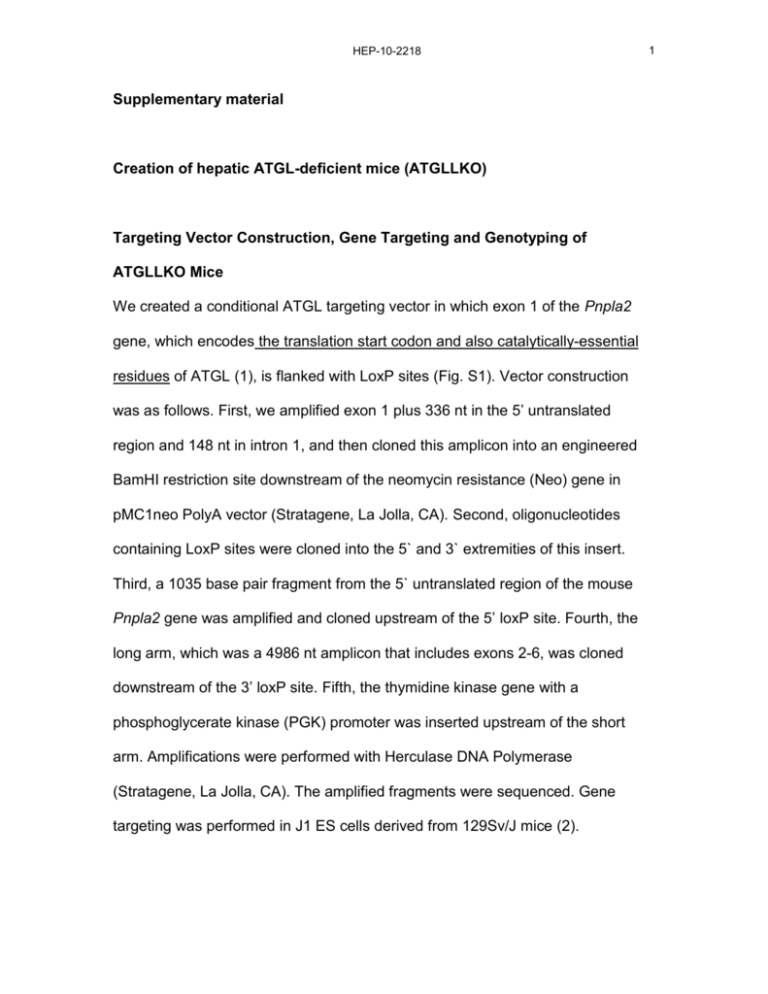HEP_24338_sm_suppinfo
advertisement

HEP-10-2218 Supplementary material Creation of hepatic ATGL-deficient mice (ATGLLKO) Targeting Vector Construction, Gene Targeting and Genotyping of ATGLLKO Mice We created a conditional ATGL targeting vector in which exon 1 of the Pnpla2 gene, which encodes the translation start codon and also catalytically-essential residues of ATGL (1), is flanked with LoxP sites (Fig. S1). Vector construction was as follows. First, we amplified exon 1 plus 336 nt in the 5’ untranslated region and 148 nt in intron 1, and then cloned this amplicon into an engineered BamHI restriction site downstream of the neomycin resistance (Neo) gene in pMC1neo PolyA vector (Stratagene, La Jolla, CA). Second, oligonucleotides containing LoxP sites were cloned into the 5` and 3` extremities of this insert. Third, a 1035 base pair fragment from the 5` untranslated region of the mouse Pnpla2 gene was amplified and cloned upstream of the 5’ loxP site. Fourth, the long arm, which was a 4986 nt amplicon that includes exons 2-6, was cloned downstream of the 3’ loxP site. Fifth, the thymidine kinase gene with a phosphoglycerate kinase (PGK) promoter was inserted upstream of the short arm. Amplifications were performed with Herculase DNA Polymerase (Stratagene, La Jolla, CA). The amplified fragments were sequenced. Gene targeting was performed in J1 ES cells derived from 129Sv/J mice (2). 1 HEP-10-2218 2 ATGL Genotyping Neomycin resistant, gancilovir-sensitive colonies were screened by PCR as follows. After washing with PBS and lysing with proteinase K, 20% of the lysate was used for PCR amplification as described (3). The sense primer MATGL25 (Table S1), which is outside the targeting vector, corresponds to residues -1500 to -1479 nt upstream of the adenine of the initiation methionine codon. The antisense primer Neo-I and PCR conditions were as described (3). A 1.4-kb amplicon was diagnostic for the targeted allele. Positive ES cell clones were confirmed by Southern blotting as follows. ES cell genomic DNA (5 µg) was digested with Nde I and Cla I. A 577-nt probe was amplified, located outside the targeting vector and spanning residues -3383 to -2804 nt upstream of the initiation ATG. Southern blotting as described (3) revealed fragment of 8.8 kb (normal, +) or 2.4 kb (Lox flanked targeted, L) (not shown). Production of mice with liver-specific ATGL deficiency Targeted clones were microinjected into C57BL/6J blastocysts and transferred to pseudopregnant recipients. Chimeras were bred to C57BL/6J mice. Agouti offspring were genotyped. Heterozygotes (ATGL +/L) were crossed with albuminCre mice (B6.Cg-Tg (Alb-cre) 21Mgn/J, 003574, the Jackson Laboratory, Bar Harbor, ME). Offspring of this cross were bred to produce ATGL L/L Cre+ mice, designated ‘’ATGLLKO ’’ (ATGL liver knockout). ATGL L/L Cre- mice were used as controls. HEP-10-2218 3 Genotyping of ATGLLKO mice PCR reactions to distinguish among normal (+), targeted (L) and heterozygous (+/L) mice were performed with 3 primers, MATGL25, MATGL31 and Neo-1 (Table S1). Mouse tail DNA was used. MATGL25 and MATGL31 amplified a 1.28 kb fragment for the normal allele and MATGL25 and Neo-1 amplified a 1.47 kb fragment for the targeted allele. Detection of the Cre transgene was with Cre-1 and Cre-2 primers, generating a 857 bp amplicon spanning Cre nucleotides 80 to 936. To demonstrate the specific excision of ATGL exon 1, liver genomic DNA (5 µg) was digested with BamHI. Using the 1035 bp targeting vector short arm fragment as probe, fragments were detected of 5.7 kb for the normal allele, 2.2 kb for the targeted allele without Cre excision and 4.9 kb for targeted allele with Cre excision (Fig 1B). Mouse breeding and animal room conditions Mice were raised with a 12-hour dark/light cycle and free access to food and water. Three cohorts of 11-12 pairs of mice were followed and were sacrificed at 4, 8 or 12 months of age. 3 or 6 weeks prior to sacrifice (see figure legends), each cohort was divided, with half receiving a normal diet (#2019, Teklad Global Rodent, 9% fat, Harlan Laboratories, Madison, WI) and half, a high fat safflower oil-based diet (HFD, #112245, 59% energy as fat, Dyets, Bethlehem, Pennsylvania) supplemented with minerals and vitamins (#210025, #310025). Littermate controls were obtained for the 8- and 12-month-old cohorts. For the 4month-old cohort, controls were selected from litters produced by the same male HEP-10-2218 4 housed with 2-3 females, and born within 2 days of each other. All experiments were approved by Canadian Council on Animal Care-accredited animal facility committee of CHU Sainte-Justine. Real time reverse transcriptase-PCR This was performed as described (4). Primers are listed in Table S2. Western blotting Western blotting was performed as described (4). The following antibodies were used: ATGL (#2138, Cell Signaling Technology, Danvers, MA); TGH (a kind gift from Richard Lehner) (5); HSL (4); microsomal triglyceride transfer protein (kindly provided by Dr. David Gordon, Bristol-Myers-Squibb) and LAMP2 (Developmental Studies Hybridoma Bank, Iowa City, Iowa). Plasma metabolites Commercial kits were used to assay plasma TG and total cholesterol (#1488872 and 450061 respectively; Roche Diagnostics, Indianapolis, IN) and nonesterified FA (Wako HR Series NEFA-HR, Wako Pure Chemical Industries, Chou-ku, Osaka). Alanine aminotransferase (ALT), aspartate aminotransferase (AST) and gamma glutamyl transferase (GGT) were measured on a clinical autoanalyser (Beckman coulter DX). 3-hydroxybutyrate was measured spectrophotometrically (6) and plasma glucose, with the ALL-IN-ONE blood glucose monitoring system (ACCU-CHEK Compact Plus, Roche Diagnostics, Indianapolis, IN) HEP-10-2218 TAG hydrolase activity assay Mice were fasted overnight and sacrificed. Livers were quickly removed, washed with cold PBS, then frozen rapidly in liquid nitrogen. About 0.5 g liver was gently homogenized in 2 mL homogenate buffer (0.5 M sucrose, 1 mM EDTA, 20 mM Tris-HCl pH 7.4, 1 mM DTE, 20 µg/mL leupeptin, 2 µg/mg antipain and 1 µg/mL pepstatine) using a dounce homogenizer. After centrifugation at 1000 g for 10 min, supernatant was taken. Then discontinuous gradient centrifugation was performed as described (7). Briefly, the sucrose gradient had three fractions with the following sucrose concentrations: 1.5 M, 0.5 M (cytoplasmic, i.e., the homogenate supernatant) and 0.25 M. Centrifugation was at 100,000 g in a swinging bucket rotor for 3 h. The 0.5 M sucrose "cytoplasmic" fraction was isolated for TG hydrolase assay and protein determination. Neutral TG hydrolase activity was assayed as described (8) with minor modifications. For substrate preparation, 0.05 µg glycerol tri [9,10 (n)-3H] oleate (GE Healthcare Bio-Sciences, Baie d’Urfé, Quebec, Canada), 147.5 µg non labelled triolein (final specific activity, 5.74 µCi/µmol) and 15 µg phosphatidylcholine/ phosphatidylinositol (PC/PI 3:1) were mixed. After drying under nitrogen, the mixture was emulsified by sonication in 75 µL 0.1M potassium phosphate, pH 7.0 and 25 µL 20% defatted BSA in 0.1 M potassium phosphate. For each assay, 100 µL substrate with 50 µL homogenate and 50 µL reaction buffer (20 mM potassium phosphate, 1 mM EDTA, 1 mM DTE and 5 HEP-10-2218 6 0.02% defatted BSA, pH 7.0) were incubated for 30 min at 37˚C. Reactions were terminated by adding 3.25 mL extraction mixture in methanol/chloroform/heptane (10/9/7, v/v/v) and 1 mL of 0.1 M potassium carbonate, 0.1 M boric acid (pH 10.5), followed by vigorous vortexing. Following centrifugation at 800 g for 15 min, scintillation counting was performed on 1 mL of the top heptane phase, which contained radiolabeled fatty acids. Tissue TG analysis Lipid extraction from liver, resolution by thin-layer chromatography and TG measurement were as described (4). Hepatic histology and ultrastructure Liver fragments in buffered formalin were paraffin-embedded. Hematoxylin eosin and Masson trichrome staining were performed. Other fragments were fixed in 0.1 M phosphate-buffered 1% glutaraldehyde (pH 7.4) for 2 hours at room temperature, stored in 0.1 M phosphate buffer (pH 7.4), then postfixed in 1% OsO4 for one hour at 4˚C, dehydrated in ethanol, and embedded in Epon for electron microscopy. Functional testing For calorimetry, mice were acclimated to metabolic chambers for 24 hours before measurement of oxygen consumption, respiratory exchange ratio (RER) and 7 HEP-10-2218 heat production (Oxymax/CLAMS, Columbus Instruments, Columbus, OH) as described (6). Insulin tolerance tests were as described (9) except that 1U/kg of insulin was used. Glucose (9) and pyruvate (10) tolerance tests, hepatic VLDL secretion (11) and in vivo lipolysis (6) were assayed as described. FA oxidation in liver slices Liver slices were prepared as described (12). Briefly, livers from overnight-fasted mice were mice were used. 500 µm slices were obtained (Vibratome, Leica VT 1000S, Germany). A 1 cm diameter circular punch was used to standardize surface area. Incubations were in sealed 25-mL Erlenmeyer center-well flasks. Substrate preparation was as described (13) with modifications. Briefly, incubations were performed in triplicate, 0.2 mM 1-14C palmitic acid (specific activity, 1 µCi/umol) bound to defatted albumin (molar ratio palmitate: albumin=6:1) in 2-mL Krebs-Ringer phosphate buffer. Before incubation, it was equilibrated for 30s with a humified 95%/5% O2/CO2 gas mix. Flasks were then capped with a rubber stopper equipped with a suspended center well and incubated for 2 h at 37˚C (pulse study). Pilot studies showed that CO2 production was linear for >2 hours under these conditions (not shown). For chase studies, triplicate liver slices were incubated as above, washed 6 times in 37˚C KrebsRinger phosphate buffer and placed in a 25-mL Erlenmeyer center-well flask as above with 0.2 M nonlabelled-palmitic acid and incubated for 1 hour. Incubations 8 HEP-10-2218 were stopped by injecting 0.4 mL of 5% (wt/vol) HClO4 into the reaction mixture. Then 0.2 mL 1M NaOH was injected into the center well (14). The flasks were shaken for a further 45 min at room temperature to trap 14CO 2. The center wells were placed in plastic vials with 10 mL of liquid scintillation fluid and assayed for radioactivity in a counter (14). Statistical analysis Values are presented as means ± SEM. Groups were compared by the paired, two-tailed Student t test unless otherwise specified. Supplementary results Gene targeting Ten of 60 ES cell clones obtained by positive-negative selection (16.7%) contained the targeted allele. Of six chimeras obtained, two males with > 80% coat color chimerism were crossed with C57BL/6 females. Both transmitted the targeted allele to offspring. HEP-10-2218 9 Supplementary references 1. Zimmermann R, Strauss JG, Haemmerle G, Schoiswohl G, BirnerGruenberger R, Riederer M, Lass A, et al. Fat mobilization in adipose tissue is promoted by adipose triglyceride lipase. Science 2004;306:1383-1386. 2. Sirois J, Cote JF, Charest A, Uetani N, Bourdeau A, Duncan SA, Daniels E, et al. Essential function of PTP-PEST during mouse embryonic vascularization, mesenchyme formation, neurogenesis and early liver development. Mech Dev 2006;123:869-880. 3. Wang SP, Marth JD, Oligny LL, Vachon M, Robert MF, Ashmarina L, Mitchell GA. 3-Hydroxy-3-methylglutaryl-CoA lyase (HL): gene targeting causes prenatal lethality in HL-deficient mice. Hum Mol Genet 1998;7:2057-2062. 4. Fortier M, Soni K, Laurin N, Wang SP, Mauriege P, Jirik FR, Mitchell GA. Human hormone-sensitive lipase (HSL): expression in white fat corrects the white adipose phenotype of HSL-deficient mice. J Lipid Res 2005;46:18601867. 5. Wei E, Ben Ali Y, Lyon J, Wang H, Nelson R, Dolinsky VW, Dyck JR, et al. Loss of TGH/Ces3 in mice decreases blood lipids, improves glucose tolerance, and increases energy expenditure. Cell Metab 2010;11:183-193. HEP-10-2218 10 6. Fortier M, Wang SP, Mauriege P, Semache M, Mfuma L, Li H, Levy E, et al. Hormone-sensitive lipase-independent adipocyte lipolysis during betaadrenergic stimulation, fasting, and dietary fat loading. Am J Physiol Endocrinol Metab 2004;287:E282-288. 7. Soni KG, Mardones GA, Sougrat R, Smirnova E, Jackson CL, Bonifacino JS. Coatomer-dependent protein delivery to lipid droplets. J Cell Sci 2009;122:1834-1841. 8. Holm C, Osterlund T. Hormone-sensitive lipase and neutral cholesteryl ester lipase. Methods Mol Biol 1999;109:109-121. 9. Roduit R, Masiello P, Wang SP, Li H, Mitchell GA, Prentki M. A role for hormone-sensitive lipase in glucose-stimulated insulin secretion: a study in hormone-sensitive lipase-deficient mice. Diabetes 2001;50:1970-1975. 10. Zhang YM, Chohnan S, Virga KG, Stevens RD, Ilkayeva OR, Wenner BR, Bain JR, et al. Chemical knockout of pantothenate kinase reveals the metabolic and genetic program responsible for hepatic coenzyme A homeostasis. Chem Biol 2007;14:291-302. 11. Liu Y, Millar JS, Cromley DA, Graham M, Crooke R, Billheimer JT, Rader DJ. Knockdown of acyl-CoA:diacylglycerol acyltransferase 2 with antisense HEP-10-2218 11 oligonucleotide reduces VLDL TG and ApoB secretion in mice. Biochim Biophys Acta 2008;1781:97-104. 12. Wu Q, Ortegon AM, Tsang B, Doege H, Feingold KR, Stahl A. FATP1 is an insulin-sensitive fatty acid transporter involved in diet-induced obesity. Mol Cell Biol 2006;26:3455-3467. 13. Mannaerts GP, Debeer LJ, Thomas J, De Schepper PJ. Mitochondrial and peroxisomal fatty acid oxidation in liver homogenates and isolated hepatocytes from control and clofibrate-treated rats. J Biol Chem 1979;254:4585-4595. 14. McGarry JD, Mannaerts GP, Foster DW. A possible role for malonyl-CoA in the regulation of hepatic fatty acid oxidation and ketogenesis. J Clin Invest 1977;60:265-270. Figure legends Figure S1 Targeting protocol (Top) Genomic organization of the Pnpla2 locus with exons shown as filled rectangles. (Center) The targeting vector. (Bottom) The targeted allele. The short arm fragment used as a probe for genomic Southern blotting is shown below the targeted allele. TK, thymidine kinase. HEP-10-2218 12 Figure S2 Similar levels of apoptosis in ATGLLKO mice liver and controls 8-month-old mice were fasted for 6 hours. Liver fragments were taken for histological studies and TUNEL staining was performed. (A) Control; (B) ATGLLKO. Apoptotic cells are indicated (arrows) (C) The numbers of TUNELpositive cells were counted per high-powered field (magnification X 400) under light microscopy in 20 random fields per liver. Figure S3 Normal glucose tolerance tests in 8- and 12-month-old ATGLLKO mice Mice were fasted for 14 hours. 1.5 g/kg of glucose were injected intraperitoneally. (A) 8-month-old mice and (B) 12-month-old mice. Solid line, WT; dashed line, ATGLLKO. Figure S4 Similar levels of TGH and microsomal triglyceride transfer protein in ATGLLKO and control livers 4-month-old mice were fasted for 6 hours. 10 μg liver protein were loaded for western blotting. (A)TGH and (B) microsomal triglyceride transfer protein. Figure S5 LAMP2 is present in similar amounts in ATGLLKO mice and controls 8-month-old mice were fasted for 6 hours. 10 μg liver protein were loaded for LAMP2 western blotting HEP-10-2218 Table S1: PCR primers used for genotyping Cre-1 Cre-2 MATGL25 MATGL31 Neo-1 GATGGACATGTTCAGGGATC AGCTTGCATGATCTCCGGTA CTCTTGATGGCTCACATCCAA CCGTTTCGGTAGACTCTCTG ATCCATCTTGTTCAATGGCCGATC C Sequences are shown from 5’ to 3’ 13 HEP-10-2218 14 Table S2: primers used for real time PCR Gene ATGL Adiponutrin HSL CGI-58 CD 36 mt GPAT DGAT1 DGAT2 FAS TIP47 OXPAT PPARα CPT-1α COX-1 PGC-1α PEPCK G6Pase LXR PPAR γ SREBP-1c TNF-α IL-6 LC3-II Atg7 Atg5 Primer (5’—3’) F: TATCCGGTGGA GAAAGAGC, F: ATTCCCCTCTTCTCTGGCCTA, F: TGAGATGGTAACTGTGAGCC, F: CTTGCTTGGACACAACCTG, F: CCTTAAAGGAATCCCCGTGT F: CAGTAACGAGTCCAGAAACCC, F: CCGTGTTTGCTCTGGCATC, F: CCTTCCTGGTGCTAGGAGTG, F: GCTGCGGAAACTTCAGGAAAT, F: TGTCCAGTGCTTACAACTCGG, F: TGTCCAGTGCTTACAACTCGG, F: GCAAACTTGGACTTGAACGACC, F: ACCAACGGGCTCATCTTCTAA, F: CTTTTATCCTCCCAGGATTTG, F: ACTGAGCTACCCTTGGGATG, F: GTGGGCGATGACATTGCC, F: CCATGCAAAGGACTAGGAACAA, F: AGGAGTGTCGACTTCGCAAA F: ACCACTCGCATTCCTTTGAC, F: 5'-GGAGCCATGGATTGCACATT, F: CCAGTGTGGGAAGCTGTCTT, F: CCGGAGAGGAGACTTCACAG, F: ACATGAGCGAGCTCATCAAG, F: CCATGATGTCATCTTCCTGC, F: GATGTGCTTCGAGATGTGTG, R: CAGTTCCACCTGCTCAGACA R: ATGTCATGCTCACCGTAGAAAGG R: CTGTCGTGGAGTTAGAGTCA R: GAGGTGACTAACCCTTGATGG R: TGCATTTGCCAATGTCTAGC R: CGCCATTGCTGTAGAAGTTGAG R: TGACCTTCTTCCCTGTAGAG R: CCAGTCAAATGCCAGCCA R: AGAGACGTGTCACTCCTGGACTT R: CAGGGCACAGGTAGTCACAC R: CAGGGCACAGGTAGTCACAC R: ATGTCACAGAACGGCTTCCTCAGG R: CAAAATGACCTAGCCTTCTATCGA R: GCTAAATACTTTGACACCGG R: TAAGGATTTCGGTGGTGACA R: ACTGAGGTGCCAGGAGCAAC R: TACCAGGGCCGATGTCAAC R: CTCTTCTTGCCGCTTCAGTTT R: TGGGTCAGCTCTTGTGAATG R: GGCCCGGGAAGTCACTGT R: AAGCAAAAGAGGAGGCAACA R: TCCACGATTTCCCAGAGAAC R: CTCTCACTCTCGTACACTTC R: TCTTCAGGCCATGTCTCATG R: CAACGTCAAATAGCTGACTC




![Historical_politcal_background_(intro)[1]](http://s2.studylib.net/store/data/005222460_1-479b8dcb7799e13bea2e28f4fa4bf82a-300x300.png)
